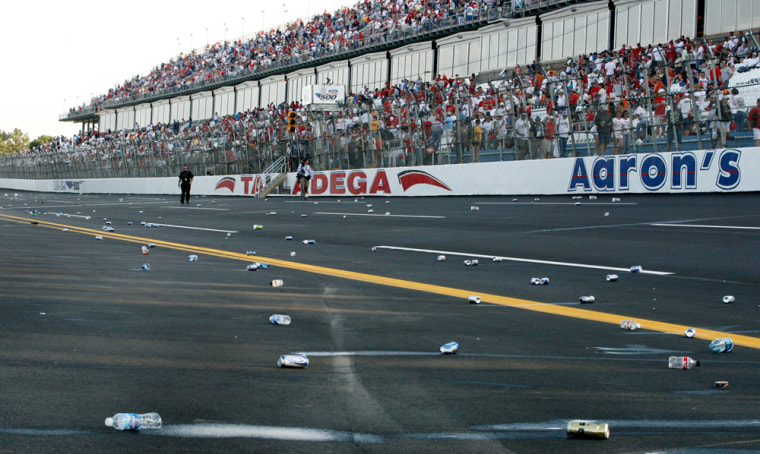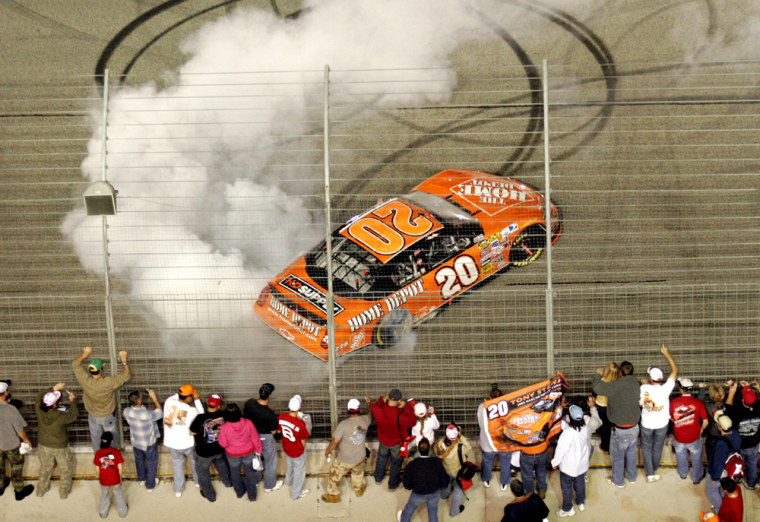In the season’s 11th hour, at a track deep inside racin’ country, six drivers with a crack at the NASCAR title were alive and fighting on the day’s final lap.
The stock-car gods had to be grinning.
But as the leaders buzzed the backstretch Nov. 5, they cut beneath tens of thousands of empty seats at Texas Motor Speedway — a remarkably light crowd despite a tight chase for the Nextel Cup.
The NASCAR bosses had to be cringing.
After a decade of wild growth, during which NASCAR zoomed to the No. 2 spot on the U.S. sports landscape and ballooned into a $3 billion behemoth, the stock-car market hit a speed bump this year. TV ratings for the races have dipped 7 percent since last season and attendance has skidded at scattered tracks — including empty seats in Charlotte, Atlanta and the smallest crowd ever to watch a NASCAR race in Indianapolis.
With the Nextel Cup finale looming Sunday, the business-end backfire has become a hot topic on the hotrod circuit. Pit road pundits question whether NASCAR is paying a price for alienating its old base — deep-fried, deer-hunting Dixieland — by courting fresh markets. With the league looking north and west to lure new fans, it now holds more races in California and New Hampshire than North and South Carolina. Next season, NASCAR also welcomes a Colombian driver from the Formula-1 world as well as Toyota cars. Heck, Betty Crocker is a modern sponsor.
What in the name of Ricky Bobby is going on in these parts?
“We’re going to be slightly back (on attendance this year),” said Roger VanDerSnick, chief marketing officer for International Speedway Corp., which owns 21 tracks across the country. “But immediately jumping to a conclusion that things are dramatically different based on one year vs. a history of growth over 50 years is probably premature.”
'Like looking at the stock market'
“Panic is not setting in,” added Andrew Giangola, NASCAR’s director of business communication. “It’s almost like looking at the stock market. There may be a month where the market is up or down, but we try to look at that long-term graph. … We have not seen a decrease in our fan base.”
Indeed, league fathers, team sponsors and track owners remain outwardly sunny about NASCAR’s tomorrow. And whether they’re filled with high-octane optimism or just offering a bit of spin, NASCAR’s leaders can quickly smooth over the 2006 rough spots.

After NASCAR almost doubled its TV ratings from 1995 to 2005, viewership dipped nearly every race this season. That included two critical, late-season races in two demographic strongholds: the UAW-Ford 500 at Alabama’s Talladega Superspeedway Oct. 8, where ratings fell 9.4 percent, and the Bank of America 500 at North Carolina’s Lowe’s Speedway Oct. 14, where ratings were off 14.6 percent.
NASCAR Chairman Brian France has pinned some of that fade on NBC. The network is in the final year of broadcasting Nextel Cup races and is “not going to promote the NASCAR events to the level that they have in previous years,” France has said.
(MSNBC.com is a joint venture of NBC Universal News and Microsoft.)
Next year, NASCAR opens an eight-season TV deal with ABC and ESPN, along with returning partners FOX and TNT — a package worth $560 million per year. The previous TV contract was valued at $400 million per year. NASCAR officials expect a race-day infusion of cool from ESPN, which will launch a slick studio show. ABC, meanwhile, represents a return to the sport’s TV roots, back when “Wide World of Sports” covered select Winston Cup races.
“In many circles, ABC Sports is credited for getting NASCAR to where it was in the 1970s and '80s for all the promotion they did,” said Dean Kessel, director of NASCAR Nextel Cup Series marketing for Sprint Nextel.
“And ESPN, whether it’s college basketball or the X Games, they know how to build sports," he said. "From our perspective, things are very, very good.”
True, NASCAR sponsors like Sprint Nextel have basked in the sport’s blistering rise from backwater passion to Madison Avenue player. There’s no better way to trace that story than to follow the changing face of NASCAR advertisers — from Winston cigarettes to NicoDerm patches, from STP motor oil and Goody’s Headache Powder to Gulfstream jets and Prilosec OTC.
Car tops, track walls and driver coveralls remain splattered with logos, alive with brand names. No other sport boasts a tighter knot between fans and advertisers. And that bond is only growing.
Some numbers:
- Sprint Nextel customers who are NASCAR fans generate 20 percent more revenue for the company that do Sprint Nextel customers who are not NASCAR fans, says the company.
- An Office Depot joint promotion with NASCAR sponsors 3M and Sharpie produced sales increases of 26 to 45 percent, according to the company.
- Sponsorship of NASCAR teams and events in 2005 was collectively valued at $5.07 billion in advertising exposure for sponsors' names and brand logos, up from $4.2 billion in 2004, according to NASCAR. Figures for 2006 are not yet available.
Compared to the National Football League or Major League Baseball, the fan-sponsor link simply reaches a higher consciousness.
“When the Denver Broncos take the field, it’s the Broncos players taking the field,” Kessel said. “When Jimmie Johnson takes the track, it’s Lowe’s taking the track.”
The old guard are grumbling
On the topic of the recent drops in TV ratings and some track attendance, Kessel said he doesn’t “see any kind of direct connect” between those trends and current sponsorship strength. He added: “We look at the aggregate of what we’re doing, and the sum of all for us is very positive.”
But in name only, one disruption may be looming at a time when some of the old guard already are grumbling. The recent merger between Sprint and Nextel means the sport’s championship series and its trophy may undergo its third name change in five seasons. NASCAR chairman France has said: “It’s not ideal. In a perfect world, you’d like to not be moving your series name around.”
“It will be Nextel through 2007. Beyond that, you do all the (due diligence) you typically do with any type of brand change,” Kessel said. “We don’t take this move very lightly. We’re respectful of the fan base, very respectful of the sport’s heritage.”
Those sensitivities have never been more critical, with NASCAR aiming to launch new races in New York City and Seattle, with more drivers hailing from California than any other state, with track seats sitting empty in Georgia, North Carolina and Texas, with more TVs tuned elsewhere in NASCAR-friendly homes.
“I don’t think a one-year snapshot tells the whole story. Trends are much more important,” said David Carter, executive director of the University of Southern California Sports Business Institute.
“Having said that, if some of the refinements don’t help them stop what appear to be small erosions in certain areas, then it become problematic," he said. "I think they’ve identified that they have to continue to lean to the tape and make sure that they are shoring up sponsorships, TV ratings, their in-venue experience — and do it without alienating their fan base.”
When you’re talking NASCAR country, you’re always talking money, even in slow years. At Texas Motor Speedway this month, track officials covered those empty swaths of backstretch with ad-emblazoned tarps — a “bird in the hand,” as TMS president Eddie Gossage put it.
“Whether we're going to sell them or not, I don’t know,” Gossage said at the time. “But we got revenue for 'em.”
